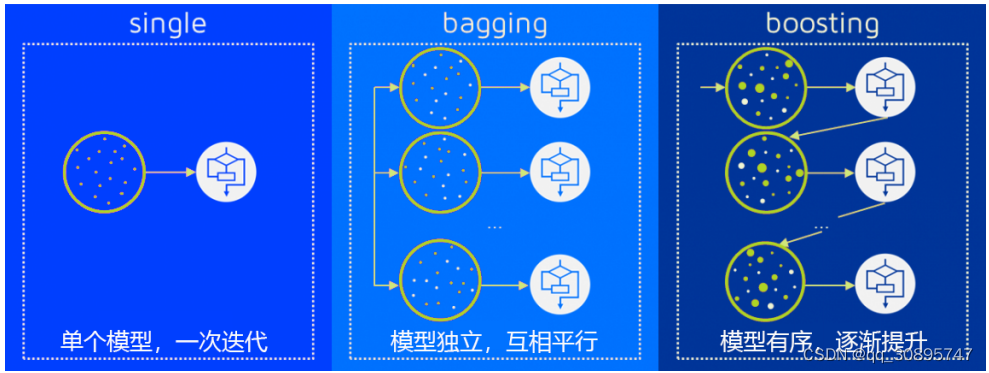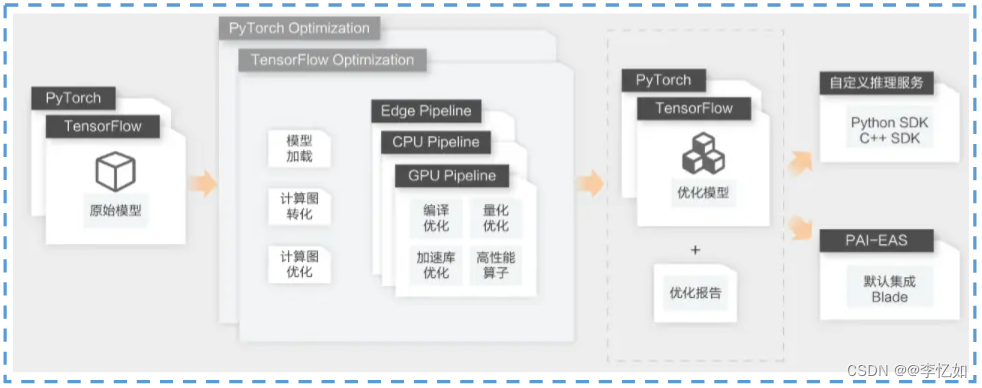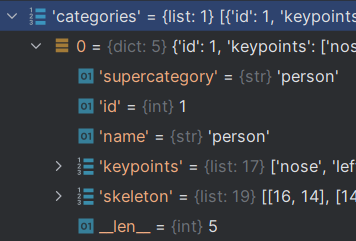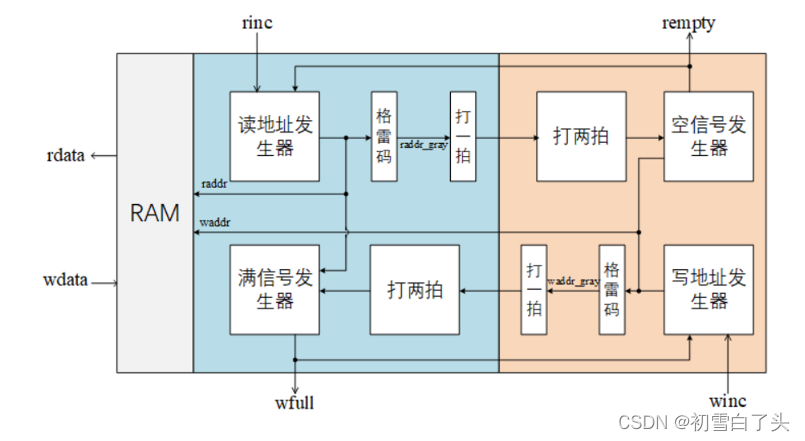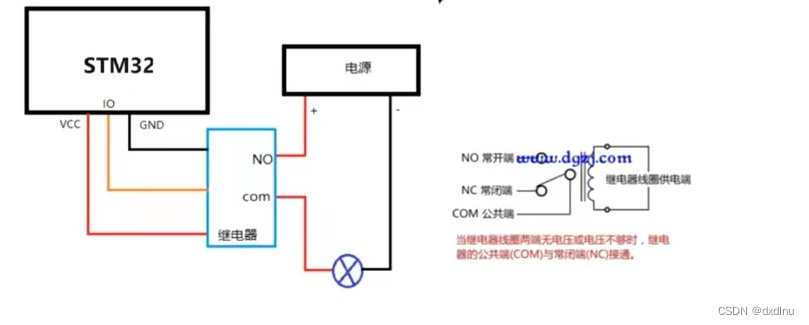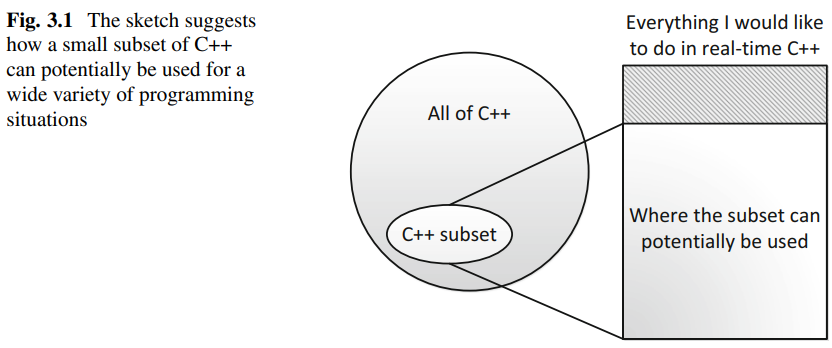一.IO流
1.什么是IO?
I:Input,数据的读取,数据的输入
数据的输入,可以是从键盘输入,从文件读取,从网络接收...
O:Output,写数据,数据的输出
数据的输出,可以是输出到控制台,写到文件,发生到网络中...
2.在java中要进行IO操作需要使用IO流类来完成
现在说的是传统的IO,阻塞式IO。
后面还会有NIO(非阻塞式IO)和AIO(异步IO)
基础阶段的IO流类:
(1)按照方向分
输入流类:
InputStream,Reader系列
输出流类:
OutputStream,Writer系列
(2)按照操作数据的方式,单位分:
字节流:
InputStream,OutputStream系列
字符流:
Reader,Writer
(3)按照角色不同
节点流:
和数据的源头/目的地连接的IO流:
FileInputStream,FileOutputStream,FileReader,FileWriter:读写文件
ByteArrayInputStream,ByteArrayOutputStream,CharArrayReader,CharArrayWriter:读写数组
....
处理流/包装流/装饰流:
它是在其他IO流基础上,增加功能用的
BufferedInputStream,BufferedOutputStream,BufferedReader,BufferedWriter,给其他IO流增加缓冲功能。
InputStreamReader,OutputStreamReader,给其他IO流转换类型用的,或者给其他IO编码,解码用的
...
区分它们的依据是创建它们的对象的方式,如果是处理流,创建调用它们的构造器创建对象时,必须传入另一个IO流对象。
FileInputStream(String name):节点流,参数不是IO流类型
BufferedInputStream(InputStream in):处理流,参数是IO流类型
3.IO流类的四个基类,四个超类,四个父类,其他的IO流都是从它们演变过来,是它们的子类。
字节输入流:InputStream
字节输出流:OutputStream
字符输入流:Reader
字符输出流:Writer
代码如下:
public class TestIO {
@Test
public void test02(){
Scanner input = new Scanner(System.in);//从键盘输入
System.out.print("输入一个姓名:");
String name = input.next();
System.out.println("name = " + name);
input.close();
}
@Test
public void test01(){
System.out.println("hello");//这个也是IO操作,把数据输出到控制台
}
}4.文件IO流(输入流)
(1)FileInputStream类
如果文件不存在,会报错java.io.FileNotFoundException:xxx(系统找不到指定的文件)
父类:InputStream类(字节输入流)
public int read():从输入流读取一个字节。返回读取的字节值。虽然读取了一个字节,但是会自动提升为int类型。如果已经到达流末尾,没有数据可读,则返回-1
public int read(byte[] b):从输入流中读取一些字节数,并将它们存储到字节数组 b 中。每次最多读取b.length个字节。返回实际读取的字节个数。如果已经到达流末尾,没有数据可读,则返回-1.
public int read(byte[] b,int off,int len):从输入流中读取一些字节数,并将它们存储到字节数组 b 中,从b[off]开始存储,返回实际读取的字节个数。如果已经到达流末尾,没有数据可读,则返回-1
public void close():关闭此输入流并释放与此流相关联的任何系统资源。
(2)FileOutputStream类
如果文件不存在,会自动创建
如果文件已存在,会覆盖原来的内容
如果要追加,在创建FileOutputStream类对象时,加一个参数true
它的父类是OutputStream类,字节输出流
public void write(int b):将指定的字节输出。虽然参数为int类型四个字节,但是只会保留一个字节的信息写出。
public void write(byte[] b):将b.length字节从指定的字节数组写入此输出流。
public void write(byte[] b,int off,int len):从指定的字节数组写入 len 字节,从偏移量 off 开始输出到此输出流。
public void close():关闭此输入流并释放与此流相关联的任何系统资源。
(3)FileReader类
父类 Reader类:
public int read(): 从输入流读取一个字符。 虽然读取了一个字符,但是会自动提升为int类型。返回该字符的Unicode编码值。如果已经到达流末尾了,则返回-1。
public int read(char[] cbuf): 从输入流中读取一些字符,并将它们存储到字符数组 cbuf中 。每次最多读取cbuf.length个字符。返回实际读取的字符个数。如果已经到达流末尾,没有数据可读,则返回-1。
public int read(char[] cbuf,int off,int len):从输入流中读取一些字符,并将它们存储到字符数组 cbuf中,从cbuf[off]开始的位置存储。每次最多读取len个字符。返回实际读取的字符个数。如果已经到达流末尾,没有数据可读,则返回-1。
public void close():关闭此流并释放与此流相关联的任何系统资源。
(4)FileWriter类
父类Writer类
public void write(int c):写入单个字符。
public void write(char[] cbuf):写入字符数组。
public void write(char[] cbuf, int off, int len):写入字符数组的某一部分,off数组的开始索引,len写的字符个数。
public void write(String str):写入字符串。
public void write(String str, int off, int len):写入字符串的某一部分,off字符串的开始索引,len写的字符个数。
public void flush():刷新该流的缓冲。
public void close():关闭此流,但要先刷新它。
5.IO流操作的步骤:
① 先选择合适的IO流类,创建它的对象
② 读或写操作
③ 关闭IO流
因为IO流类的对象会在JVM内存中开辟空间。这个部分的内存,可以有JVM的GC自动回收
但是IO流的操作还会在JVM内存的外部开辟空间,因为IO操作需要用到操作系统的一些函数,这些内存GC是无法回收的。
那么要通过调用close方法,通知操作系统释放对应的内存。
代码如下:
FileInputStream类
public class TestFileInputStream {
@Test
public void test04() throws IOException {
/*
要以字节的方式读取一个文件:当前模块下的文件1.txt
*/
FileInputStream fis = new FileInputStream("1.txt");//相对路径
byte[] data = new byte[2];
while(true) {
int len = fis.read(data);//数据读取到data字节数组中
if(len == -1){
break;
}
System.out.println("len = " + len);
// System.out.println(Arrays.toString(data));//[97,98]
System.out.println(new String(data,0,len));//本次读取了几个字节,就用几个字节构造字符串
}
fis.close();
}
@Test
public void test03() throws IOException {
/*
要以字节的方式读取一个文件:当前模块下的文件1.txt
*/
FileInputStream fis = new FileInputStream("1.txt");//相对路径
while(true){
int read = fis.read();
if(read == -1){
break;
}
System.out.println(read);
}
fis.close();
}
@Test
public void test02() throws IOException {
/*
要以字节的方式读取一个文件:当前模块下的文件1.txt
*/
FileInputStream fis = new FileInputStream("1.txt");//相对路径
byte[] data = new byte[2];
int len = fis.read(data);//数据读取到data字节数组中
System.out.println("len = " + len);//2
System.out.println(Arrays.toString(data));//[97,98]
len = fis.read(data);
System.out.println("len = " + len);//1
System.out.println(Arrays.toString(data));//[99, 98] 这个98是上次读取的,本次只读取了一个字节
len = fis.read(data);
System.out.println("len = " + len);//-1
System.out.println(Arrays.toString(data));//[99, 98] 这个99,98是上次读取的,本次只读取了一个字节
fis.close();
}
@Test
public void test01() throws IOException {
/*
要以字节的方式读取一个文件:当前模块下的文件1.txt
*/
FileInputStream fis = new FileInputStream("1.txt");//相对路径
System.out.println(fis.read());
System.out.println(fis.read());
System.out.println(fis.read());
System.out.println(fis.read());
fis.close();
}
}FileOutputStream类(代码演示)
public class TestFileOutputStream {
@Test
public void test03() throws IOException {
//输出hello到1.txt,接着原来内容写
FileOutputStream fos = new FileOutputStream("1.txt",true);//已存在 true表示追加
//把字符串转为字节数组
fos.write("hello".getBytes());
fos.close();
}
@Test
public void test02() throws IOException {
//输出houxiaosun到1.txt
FileOutputStream fos = new FileOutputStream("1.txt");//已存在
//把字符串转为字节数组
fos.write("houxiaosun".getBytes());
fos.close();
}
@Test
public void test01() throws IOException {
//输出chai到1.txt
FileOutputStream fos = new FileOutputStream("1.txt");
//把字符串转为字节数组
fos.write("chai".getBytes());
fos.close();
}
}FileReader类
public class TestFileReader {
@Test
public void test02()throws IOException{
/*
要以字符的方式读取一个文件:当前模块下的文件1.txt
*/
FileReader fr = new FileReader("1.txt");
char[] data = new char[2];
int len;
while((len = fr.read(data)) != -1){
System.out.println(new String(data,0,len));
}
fr.close();
}
@Test
public void test01()throws IOException {
/*
要以字节的方式读取一个文件:当前模块下的文件1.txt
*/
FileInputStream fis = new FileInputStream("1.txt");//相对路径
byte[] data = new byte[3];
while(true) {
int len = fis.read(data);//数据读取到data字节数组中
if(len == -1){
break;
}
System.out.println(new String(data,0,len));//本次读取了几个字节,就用几个字节构造字符串
//new String就是解码操作,但是发现乱码了
}
fis.close();
}
}FileWriter类
public class TestFileWriter {
@Test
public void test()throws IOException {
//输出一句话到1.txt
FileWriter fw = new FileWriter("1.txt",true);//true表示追加
fw.write("我爱你");
fw.close();
}
}练习题:使用文件字节流复制一个视频文件
例如:D:\atguigu\javaee\JavaSE20220106\video\day0107_01video\day0107_01JavaSE阶段学什么.avi
复制到当前工程的根目录
复制文件:其实就是读一个文件,然后把读取的数据写到另一个文件
public class Exercise3 {
@Test
public void test()throws IOException{
FileInputStream fis = new FileInputStream("D:\\atguigu\\javaee\\JavaSE20220106\\video\\day0107_01video\\day0107_01JavaSE阶段学什么.avi");
//要求上面这个文件必须存在,否则会报错
FileOutputStream fos = new FileOutputStream("day0107_01JavaSE阶段学什么1.avi");
//下面这个文件可以不存在
byte[] data = new byte[1024];//一次读取1KB
/* while(fis.read(data) != -1){//错误,因为这个循环会导致每次循环读了两次,一次用于判断,一次用于输出
fos.write(fis.read(data));
}*/
int len;
while((len= fis.read(data)) !=-1){
fos.write(data,0,len);
}
fis.close();
fos.close();
}
public static void main(String[] args) throws IOException {
FileInputStream fis = new FileInputStream("D:\\atguigu\\javaee\\JavaSE20220106\\video\\day0107_01video\\day0107_01JavaSE阶段学什么.avi");
//要求上面这个文件必须存在,否则会报错
FileOutputStream fos = new FileOutputStream("day0107_01JavaSE阶段学什么.avi");
//下面这个文件可以不存在
byte[] data = new byte[1024];//一次读取1KB
while(true){
int len = fis.read(data);//从源文件读取len个字节
if(len == -1){
break;
}
fos.write(data,0,len);//把本次读取的len个字节写到目标文件中
}
fis.close();
fos.close();
}
}6.IO流的问题
(1)关于直接基于"文件夹/目录"创建IO流对象是错误的
会报java.io.FileNotFoundException:d:\download(拒绝访问)
(2)输出流如果不能及时关闭(因为可能后面还要用),但是又想要数据及时输出,可以调用flush方法,但是如果后面不用啦,一定要close。因为close不仅仅是刷数据的问题,还涉及到内存回收问题。
public class TestProblem {
@Test
public void test02()throws IOException{
FileWriter fw = new FileWriter("1.txt");
fw.write("柴林燕");
/*
像FileWriter等很多的输出流的内部有自己的一个小小缓冲区,
它在调用write方法时,会先将数据写到缓冲区。
当缓冲区满的时候,会自动“溢出”到文件。
当缓冲区没满的时候,会close方法执行时,把缓冲区的数据“清空”输出。
*/
//如果希望数据及时写出,但是暂时还不close
fw.flush();//刷新
fw.write("是Java讲师");
fw.flush();
fw.close();
fw.write("很棒");//java.io.IOException: Stream closed
fw.close();//这个就是错误的,因为已经close过了
}
@Test
public void test01()throws IOException {
// FileInputStream fis = new FileInputStream("d:\\download");
//java.io.FileNotFoundException: d:\download (拒绝访问。)
// 文件IO必须基于文件路径创建对象
//"d:\\download"这个是一个文件夹的路径,不是一个文件的路径
// FileOutputStream fos = new FileOutputStream("d:\\download");
//java.io.FileNotFoundException: d:\download (拒绝访问。)
//就算是让 FileOutputStream帮你自动创建文件,也必须在IO流的构造器中,指明文件的名称。
}
}7.缓冲流:
作用是给其他IO流增加缓冲区,提高效率
缓冲流的使用必须基于其他的IO流,也就是说,缓冲流它只能是装修(包装)别的流。
BufferedInputStream:只能包装InputStream系列的IO流
BufferedOutputStream:只能包装OutputStream系列的IO流
BufferedReader:只能包装Reader系列的IO流
BufferedWriter:只能包装Writer系列的IO流
原理:所有的缓存流在内部会开辟一块更大的缓存区,默认大小是8192字节/字符(本质就是一个8192长度的byte/char数组)
另外,对于BufferedReader和BufferedWriter来说,它除了提高效率之外,
还可以使用下面两个方法,使得读写更方便:
BufferedReader类的 String readLine() 读取一整行
BufferedWriter类的void newLine() 写入一整行
代码演示:
public class TestBuffered {
@Test
public void test05()throws IOException{
//一行一行的写数据
FileWriter fw = new FileWriter("1.txt");
BufferedWriter bw = new BufferedWriter(fw);
bw.write("hello");
bw.newLine();//一行一行的写数据
bw.write("java");
bw.newLine();
bw.write("world");
bw.newLine();
bw.write("aa");
bw.close();
fw.close();
}
@Test
public void test04()throws IOException{
//一行一行的写数据
FileWriter fw = new FileWriter("1.txt");
fw.write("hello");
fw.write("\r\n");
fw.write("java");
fw.write("\r\n");
fw.write("world");
fw.write("\r\n");
fw.write("aa");
fw.close();
}
@Test
public void test03()throws IOException {
FileReader fr = new FileReader("1.txt");
BufferedReader br = new BufferedReader(fr);//包装fr
String str;
while((str=br.readLine())!=null){//一行一行的读数据
System.out.println(str);
}
br.close();
fr.close();
}
@Test
public void test02()throws IOException {
long start = System.currentTimeMillis();
/*
演示 BufferedInputStream包装FileInputStream
BufferedOutputStream包装FileOutputStream
来完成复制文件。
D:\software\IntelliJ IDEA\ideaIU-2020.3.1.win.zip
*/
FileInputStream fis = new FileInputStream("D:\\software\\IntelliJ IDEA\\ideaIU-2020.3.1.win.zip");
BufferedInputStream bis = new BufferedInputStream(fis);//BufferedInputStream包装FileInputStream的对象
FileOutputStream fos = new FileOutputStream("D:\\idea2.zip");
BufferedOutputStream bos = new BufferedOutputStream(fos);
byte[] data = new byte[1024];
int len;
while((len = bis.read(data)) != -1){
bos.write(data,0,len);
}
bis.close();
fis.close();
bos.close();
fos.close();
long end = System.currentTimeMillis();
System.out.println("耗时:" + (end-start));//耗时:6164
}
@Test
public void test01()throws IOException {
long start = System.currentTimeMillis();
/*
演示 BufferedInputStream包装FileInputStream
BufferedOutputStream包装FileOutputStream
来完成复制文件。
D:\software\IntelliJ IDEA\ideaIU-2020.3.1.win.zip
*/
FileInputStream fis = new FileInputStream("D:\\software\\IntelliJ IDEA\\ideaIU-2020.3.1.win.zip");
FileOutputStream fos = new FileOutputStream("D:\\idea3.zip");
byte[] data = new byte[1024];
int len;
while((len = fis.read(data)) != -1){
fos.write(data,0,len);
}
fis.close();
fos.close();
long end = System.currentTimeMillis();
System.out.println("耗时:" + (end-start));//42063
}
}有无缓冲区的不同:
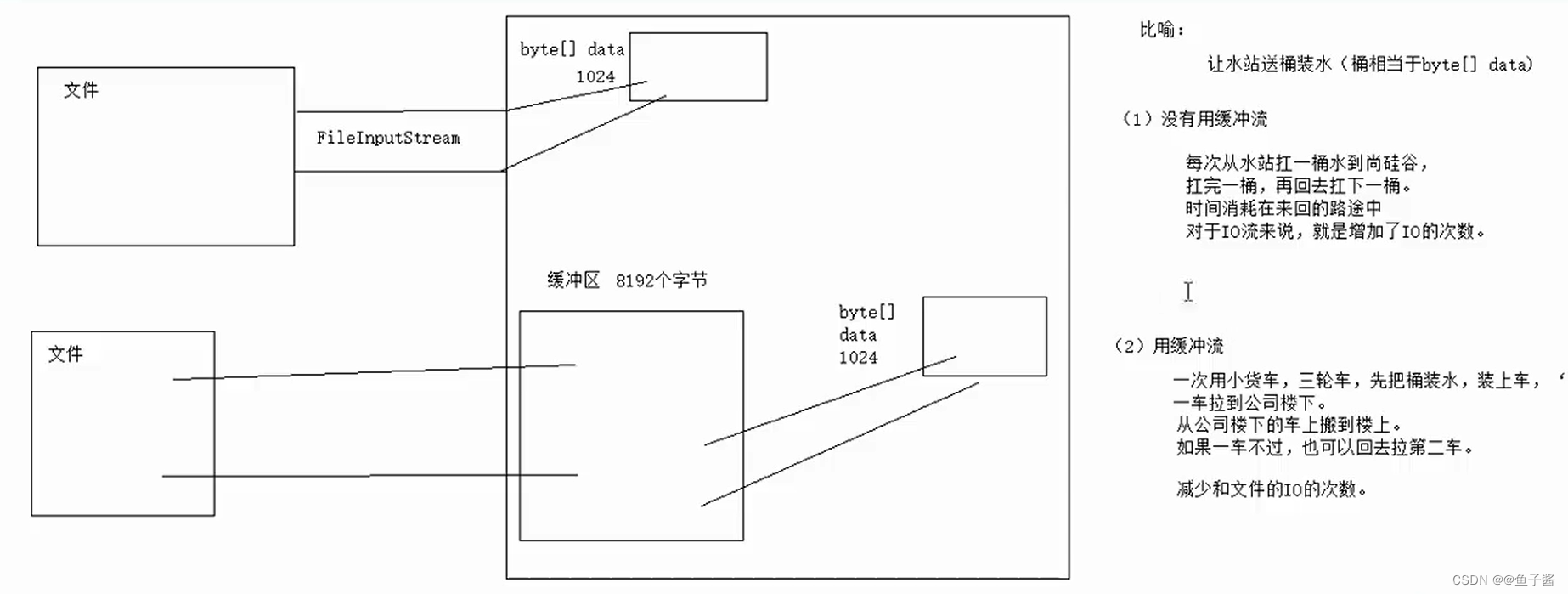
8.IO流的关闭顺序:
IO流有依赖关系。外层的包装流依赖于内存的被包装流。
比如:BufferedInputStream 依赖于 FileInputStream
BufferedOutputStream 依赖于 FileOutputStream
如果把内层的IO先关闭了,外层IO流就失去了依赖,就会报错。
比喻:我坐在凳子上,我依赖于凳子,如果把凳子先撤了,我就会摔倒。
先让我站起来,然后撤凳子。
关闭的顺序是:先关闭外层的包装流,再关闭内层的被包装流。
本质:
这段代码数据的流向: 源文件 -> fis -> bis -> data数组 -> bos -> fos ->目标文件.
BufferedOutputStream和FileOutputStream,如果把fos先关了,
bos中的缓冲的数据没有办法完全写出。因为close时,会清空缓冲区。
好记:
fis被包装在里面的,比喻成内衣,先穿内衣,再穿外衣。
bis相当于外套。
fos是内衣,bos是外套。
关闭好比是脱衣服。
先脱外套,再脱内衣。
或者,先new的后关。
fis和bis有顺序关系
fos和bos有顺序关系
fis和bis 、 fos和bos是没有顺序关系。
演示代码:
public class TestClose {
@Test
public void test02()throws IOException {
FileInputStream fis = new FileInputStream("D:\\atguigu\\javaee\\JavaSE20220106\\video\\day0107_01video\\day0107_01JavaSE阶段学什么.avi");
BufferedInputStream bis = new BufferedInputStream(fis);//BufferedInputStream包装FileInputStream的对象
FileOutputStream fos = new FileOutputStream("JavaSE.avi");
BufferedOutputStream bos = new BufferedOutputStream(fos);
/*
这段代码数据的流向: 源文件 -> fis -> bis -> data数组 -> bos -> fos ->目标文件
*/
byte[] data = new byte[1024];
int len;
while((len = bis.read(data)) != -1){
bos.write(data,0,len);
}
fis.close();
fos.close();
bis.close();
bos.close();//java.io.IOException: Stream Closed
//应该先关闭外层,再关闭内层
}
}9.编码与解码问题
使用FileReader和FileWriter去操作和当前程序编码不一致的文件时,就会出现乱码的问题,怎么解决?
使用InputStreamReader:输入流
OutputStreamReader:输出流
构造方法摘要:
InputStreamReader(InputStream in):创建一个使用默认字符集的 InputStreamReader。
InputStreamReader(InputStream in,Charset cs):创建使用给定字符集的 InputStreamReader。
InputStreamReader(InputStream in,CharsetDecoder dec):创建使用给定字符集解码器的 InputStreamReader。
InputStreamReader(InputStream in,String charsetName):创建使用指定字符集的 InputStreamReader。
代码演示:
public class TestInputStreamReader {
@Test
public void test04()throws IOException{
//输出尚硅谷太棒了到GBK编码的1.txt文件中
//加入缓冲流提高效率
FileOutputStream fos = new FileOutputStream("1.txt");
//(1)可以加入这个位置
BufferedOutputStream bos = new BufferedOutputStream(fos);//因为被包装的fos是字节流
OutputStreamWriter osw = new OutputStreamWriter(bos,"GBK");//把字符数据用GBK编码转为字节数据输出
//(2)也可以加入这儿
BufferedWriter bw = new BufferedWriter(osw);//因为osw是字符流
bw.write("尚硅谷太棒了");
bw.close();
osw.close();
bos.close();
fos.close();
}
@Test
public void test03()throws IOException{
//输出尚硅谷太棒了到GBK编码的1.txt文件中
FileOutputStream fos = new FileOutputStream("1.txt");
OutputStreamWriter osw = new OutputStreamWriter(fos,"GBK");//把字符数据用GBK编码转为字节数据输出
osw.write("尚硅谷太棒了");
osw.close();
fos.close();
}
@Test
public void test02()throws IOException {
FileInputStream fis = new FileInputStream("1.txt");
InputStreamReader isr = new InputStreamReader(fis,"GBK");//文件的编码是GBK,用GBK解从文件读取的数据
char[] data = new char[10];
int len;
while((len = isr.read(data)) != -1){
System.out.println(new String(data,0,len));
}
isr.close();
fis.close();
}
@Test
public void test01()throws IOException {
FileReader fr = new FileReader("1.txt");//1.txt的编码是GBK
char[] data = new char[10];
int len;
while((len = fr.read(data)) != -1){
System.out.println(new String(data,0,len));
}
fr.close();
}
}10.对象序列化和反序列化
IO流:
字节流,可以读/写 图片,视频,文本等。
字符流,只能读/写 文本(字符串,char)
如果要处理Java程序中的各种数据类型的数据,就需要用
DataInputStream:读Java各种基本数据类型的数据+String。
DataOutputStream:写Java各种基本数据类型的数据+String。
ObjectInputStream:读Java任意类型,包括对象。
ObjectOutputStream:写Java任意类型,包括对象。
序列化:把Java对象直接转化为字节序列过程,这个过程称为序列化,要求这个对象的类型必须实现java.io.Serializable接口,否则无法支持序列化。
反序列化:把字节序列转为Java对象的过程。
反序列化失败问题:
当数据已经序列化好之后,对Student类做了修改,导致反序列化的代码运行失败;报错: java.io.InvalidClassException(无效的类异常): com.atguigu.object.Student;
local(本地) class incompatible(不相容的;矛盾的;):stream(流) classdesc(类描述) serialVersionUID(序列化版本ID) = -3979294235569238736,local(本地) class serialVersionUID(序列化版本ID) = 5212389082514962991
如果在类声明并实现java.io.Serializable接口时,如果没有固定serialVersionUID(序列化版本ID)值,那么会在每一次编译类的时候,会产生一个新的serialVersionUID(序列化版本ID)值。
修改Student类,就会导致类重新编译。
如何解决这个问题?
在类声明并实现java.io.Serializable接口时,固定 serialVersionUID(序列化版本ID)值。
不参与序列化的字段:
① transient修饰的属性字段
② static修饰的属性字段
Student类代码:
public class Student implements Serializable {
private static final long serialVersionUID = -3979294235569238736L;
private static int total = 1;
private int id;
private String name;
private int age;
private transient int score;//transient瞬时的,临时,序列化时遇到transient标记的字段,会忽略它
private String tel;
public Student(String name, int age, int score) {
id=total++;
this.name = name;
this.age = age;
this.score = score;
}
public String getName() {
return name;
}
public void setName(String name) {
this.name = name;
}
public int getAge() {
return age;
}
public void setAge(int age) {
this.age = age;
}
public int getScore() {
return score;
}
public void setScore(int score) {
this.score = score;
}
public static int getTotal() {
return total;
}
public static void setTotal(int total) {
Student.total = total;
}
@Override
public String toString() {
return "Student{" +
"id=" + id +
", name='" + name + '\'' +
", age=" + age +
", score=" + score +
", tel='" + tel + '\'' +
'}';
}
}测试代码:TestObjectIO类:
public class TestObjectIO {
@Test
public void test04()throws Exception{
//在stu.dat文件中增加一个对象
FileInputStream fis = new FileInputStream("stu.dat");
ObjectInputStream ois = new ObjectInputStream(fis);
ArrayList<Student> list = (ArrayList<Student>) ois.readObject();
list.add(new Student("沈彦",22,100));
System.out.println(list);
ois.close();
fis.close();
FileOutputStream fos = new FileOutputStream("stu.dat");
ObjectOutputStream oos = new ObjectOutputStream(fos);
oos.writeObject(list);
oos.close();
fos.close();
}
@Test
public void test03()throws Exception{
Student s1 = new Student("李四",24,88);
Student s2= new Student("王五",24,90);
Student s3 = new Student("赵六",24,100);
ArrayList<Student> list = new ArrayList<>();
list.add(s1);
list.add(s2);
list.add(s3);
//同时序列化多个对象时,怎么办?
//放到集合里面。
FileOutputStream fos = new FileOutputStream("stu.dat");
ObjectOutputStream oos = new ObjectOutputStream(fos);
oos.writeObject(list);
oos.close();
fos.close();
}
@Test
public void test02() throws IOException, ClassNotFoundException {
Student s1 = new Student("李四",24,0);
Student s2= new Student("王五",24,0);
Student s3 = new Student("赵六",24,0);
System.out.println(Student.getTotal());
FileInputStream fis = new FileInputStream("game.dat");
ObjectInputStream ois = new ObjectInputStream(fis);
//读的顺序要与写的顺序一致
String name = ois.readUTF();
int age = ois.readInt();
char gender = ois.readChar();
int energy = ois.readInt();
double price = ois.readDouble();
boolean relive = ois.readBoolean();
Object object = ois.readObject();
System.out.println("name = " + name);
System.out.println("age = " + age);
System.out.println("gender = " + gender);
System.out.println("energy = " + energy);
System.out.println("price = " + price);
System.out.println("relive = " + relive);
System.out.println("object = " + object);
System.out.println(Student.getTotal());
ois.close();
fis.close();
}
@Test
public void test01()throws IOException {
String name ="巫师";
int age = 300;
char gender ='男';
int energy = 5000;
double price = 75.5;
boolean relive = true;
Student stu = new Student("张三",23,89);
//输出到文件
FileOutputStream fos = new FileOutputStream("game.dat");
ObjectOutputStream oos = new ObjectOutputStream(fos);
oos.writeUTF(name);
oos.writeInt(age);
oos.writeChar(gender);
oos.writeInt(energy);
oos.writeDouble(price);
oos.writeBoolean(relive);
oos.writeObject(stu);
//java.io.NotSerializableException: com.atguigu.object.Student
System.out.println(Student.getTotal());
oos.close();
fos.close();
}
}11.Scanner类与IO流
java.util.Scanner类,不是只能用来从键盘输入数据,它可以从任意流中扫描数据。
如果没有修改过System.in,那么Scanner input = new Scanner(System.in);默认是从键盘输入
在创建Scanner对象时,指定了其他的IO流,会从其他IO流中读取文本数据。
示例代码:
public class TestScanner {
@Test
public void test01()throws Exception{
//从2.txt文件中获取数据
Scanner input = new Scanner(new FileInputStream("2.txt"));
while(input.hasNextLine()){
String line = input.nextLine();
System.out.println(line);
}
input.close();
}12.System类与IO流
System类中有三个常量对象:
① public final static InputStream in = null;
② public final static PrintStream out = null;
③ public final static PrintStream err = null;
常量对象正常是以大写字母开头,但System的三个常量对象是以小写字母开头,而且用 final 修饰的变量是不可变的,但是System类的底层有set方法,可以设置in,out,err的值,即下面方法:
① public static void setIn(InputStream in)
② public static void setOut(PrintStream out)
③ public static void setErr(PrintStream err)
底层是用native修饰的,来更改in,out,err的值。
private static native void setIn0(InputStream in);
private static native void setOut0(PrintStream out);
private static native void setErr0(PrintStream err);
示例代码如下:
public class TestSystem {
@Test
public void test02()throws IOException {
System.setIn(new FileInputStream("2.txt"));
//此时默认是从 2.txt 文件中获取数据
Scanner input = new Scanner(System.in);
while(input.hasNextLine()){
String line = input.nextLine();
System.out.println(line);
}
input.close();
}
@Test
public void test01(){
InputStream in = System.in;
PrintStream out = System.out;
PrintStream err = System.err;
out.println("hello");
err.println("world");
}
}13.PrintStream类
PrintStream打印流:
① 可以支持各种数据类型的打印
② 可以支持输出换行,输出不换行,还支持格式化输出
print(xxx);输出不换行
println(xxx);输出换行
printf(xx);格式化输出
③ 输出可以输出到各种其他IO流中,也可以直接输出到文件,也可以输出到控制台。
public class TestPrintStream {
@Test
public void test01()throws IOException {
//以 UTF-8 的编码形式,输入到 3.txt 文件中
PrintStream ps = new PrintStream("3.txt","UTF-8");
ps.println("hello");
ps.println("world");
ps.close();
}
}14.try...catch新语法自动关闭IO流
JDK1.7版本之前:
代码如下:
public class TestTryCatch {
@Test
public void test01(){
FileInputStream fis = null;
InputStreamReader isr = null;
BufferedReader br = null;
FileOutputStream fos = null;
OutputStreamWriter osw = null;
BufferedWriter bw = null;
try {
//GBK编码的1.txt,复制UTF-8的2.txt文件
fis = new FileInputStream("1.txt");
isr = new InputStreamReader(fis,"GBK");
br = new BufferedReader(isr);
fos = new FileOutputStream("2.txt");
osw = new OutputStreamWriter(fos, "UTF-8");
bw = new BufferedWriter(osw);
String line;
while((line = br.readLine()) != null){
bw.write(line);
bw.newLine();
}
} catch (IOException e) {
e.printStackTrace();
}finally{
/* try {
bw.close();
osw.close();
fos.close();
br.close();
isr.close();
fis.close();
} catch (IOException e) {
e.printStackTrace();
}*/
try {
if(bw!=null) {
bw.close();
}
} catch (IOException e) {
e.printStackTrace();
}
try {
if(osw != null) {
osw.close();
}
} catch (IOException e) {
e.printStackTrace();
}
try {
if(fos != null){
fos.close();
}
} catch (IOException e) {
e.printStackTrace();
}
try {
if(br != null){
br.close();
}
} catch (IOException e) {
e.printStackTrace();
}
try {
if(isr != null) {
isr.close();
}
} catch (IOException e) {
e.printStackTrace();
}
try {
if(fis != null) {
fis.close();
}
} catch (IOException e) {
e.printStackTrace();
}
}
}
}这种try...catch非常麻烦,finally里面如果有异常的话,需要一个一个来try...catch很麻烦,所以JDK1.7之后,就有了新的方法
try(需要自动关闭的资源的对象的声明和创建){
需要异常检查的业务逻辑代码
}catch(异常类型 e){
异常处理代码
}finally{
这里写的是其他的必须执行的代码,但是不是资源关闭的代码。
}
try()中不是所有类型的对象的声明和创建都可以放进去的,只能放实现了 AutoClose 接口的类型
只有在try()中声明的才会自动关闭。不在这里声明的不会自动关闭。
在try()中声明的变量,会自动加 final
public class TestTryCatch {
@Test
public void test02(){
//GBK编码的1.txt,复制UTF-8的2.txt文件
try(
FileInputStream fis = new FileInputStream("1.txt");
InputStreamReader isr = new InputStreamReader(fis,"GBK");
BufferedReader br = new BufferedReader(isr);
FileOutputStream fos = new FileOutputStream("2.txt");
OutputStreamWriter osw = new OutputStreamWriter(fos, "UTF-8");
BufferedWriter bw = new BufferedWriter(osw);
) {
String line;
while ((line = br.readLine()) != null) {
bw.write(line);
bw.newLine();
}
}catch(IOException e){
e.printStackTrace();
}
//自动关闭,不需要写了
/* bw.close();
osw.close();
fos.close();
br.close();
isr.close();
fis.close();*/
}
}
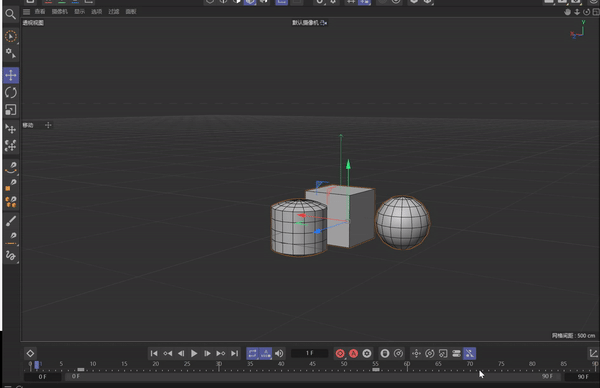

![[Data structure]栈](https://img-blog.csdnimg.cn/166e6610fcdb438a90f04a640dd5de0e.png)
